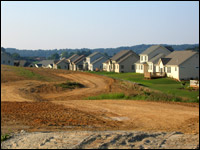Imagine a country — we’ll call it Hobsonia — that requires all its residents to shop at officially assigned supermarkets based on where they live. Now, Hobsonians care passionately about food, and since the law allows them to move if they wish, citizens decide where to live based largely on where they can buy groceries. Those with money move to the best supermarket districts, which tend to be in affluent areas where store managers know that unhappy customers have the scratch to move elsewhere. Hobsonia thus sorts itself into good supermarket districts and bad. While people talk passionately about improving the latter, nothing ever seems to make much difference.
In America, we understand that shopping is too important for us to forbid people from changing stores without moving. So we only apply this Hobsonian policy to public education.

Teach your children well.
As we trundle our little ones onto those yellow buses for yet another school year, it’s worth pausing for a moment to consider the role of schools in the frenzied conversion of open space to strip malls and subdivisions — a process known familiarly as sprawl. This car-oriented, low-density development on the edge of metropolitan areas isn’t pretty; it means more paving, greenhouse gases, and traffic fatalities, not to mention less mobility for the young and the elderly. Sprawling communities are associated with obesity, probably because nobody walks anywhere, and they also strike many of us as alienating and indistinguishable.
Where do schools come in? The standard formulation is that sprawl harms urban school systems by draining middle-class students and their tax-paying families. But any parent will tell you that urban schools also promote sprawl by driving away families who can afford to leave. Michael E. Lewyn, a visiting professor of law at George Washington University, has observed that we give urban parents three choices: They can send their kids to the lousy and possibly dangerous public schools in the city. They can ante up the exorbitant tuition for private school, assuming their kids can get in. Or they can move to the best suburb they can afford, where decent public schools are available to anyone with the price of a house.
While some people genuinely like faceless suburbs, many of us who loathe them move there anyway because of our kids. We tolerate boredom, protracted commutes, and endless shuttling from errand to errand by minivan because, much as we loved Thai food and art museums, there was no acceptable place in the city to educate our children. In a 2004 paper in the Journal of the American Planning Association entitled “Smart Growth and School Reform,” University of Maryland urbanologist Howell S. Baum says it plainly: “Improving city schools is central to managing sprawl.”

Their parents’ hell …
Ignoring the chain of causality between bad schools and sprawl leads environmentalists to overlook the simplest and potentially most powerful anti-sprawl measure available, which is to let urban parents choose their kids’ schools — even if those schools aren’t in the city or aren’t even public. Ethically, this notion is supposed to be anathema. Surely we can’t trust urban parents to choose their children’s schools. Why don’t we just improve the inner-city schools? Maybe more testing will work. Or how about vastly greater funding? Perhaps smaller class sizes, bilingual education, phonics, or school uniforms will do the trick.
These views are held by most of the caring people I know, but I notice that hardly any of them send their kids to an inner-city school — except, perhaps, for the odd island of success in an ocean of pedagogical failure. These few thriving urban schools tend to be in expensive neighborhoods, or magnet schools with special programs. Either way, admission is essentially voluntary. So why not give everyone this choice? Why not let parents pick any school, public or private, that meets official requirements? Even excluding private schools, a sensible system could still let parents choose freely from among any public schools that will have their kids — even schools in different districts.
It’s hard to predict how many middle-class families would choose urban life if they didn’t have to worry about the schools, but it’s fair to assume the proportion would be substantial. The childless bourgeoisie are a fixture of urban life in most major cities, and the couples who move out to some new subdivision when they have kids are stock figures as well. Duke University economist Thomas Nechyba, who has created a theoretical model of the relationship between school choice and housing decisions, finds in his simulation that giving all parents school vouchers substantially boosted household income in poor school districts. The reason? Many affluent people moved back.
Oh yeah, and as a bonus, school choice could also help desegregate the cities, rescue them from their never-ending financial crises, force them to provide competitive educational offerings, reduce air pollution, and maybe even save some lives on the nation’s highways.
Of course, there are other reasons — reasons of justice and racial equality and economic fairness — to give parents much greater school choice. Why, after all, should only the poorest families, those whose kids desperately need better schooling to break the cycle of poverty, find themselves unable to opt out of bad schools? How are we ever going to narrow the gap between rich and poor if a good education depends on how much real estate you can afford?
These arguments mysteriously fail to resonate among many of the environmentally minded people I know. One reason might be that environmentalists are generally an affluent bunch, and thus are beneficiaries of the lopsided school-choice voucher system already in place in our society. These vouchers — the technical term for them is “cash” — are used by middle-class parents to hire moving vans and buy houses in the suburbs. Like our health insurance system, it works great — if you can afford it.
Another reason might be the mechanism — competition — whereby school choice would work. Many of the environmentally minded people I know are uncomfortable with competition, which sounds a little too red in tooth and claw. But competition among schools already works: competition in higher education has led to excellent quality and lots of choices. And environmentalists have managed to warm up to the competitive marketplace before. Markets in sulfur-dioxide emissions credits and halibut fishing rights, to cite just two examples, have proven their mettle in cost-effectively achieving environmental goals.
Why not a more competitive marketplace in schooling? Imagine if Americans could choose a new school without necessarily having to choose a new community. Maybe then the demand driving sprawl would slow down, and the rate of land development would fall back a bit toward the rate of population growth. We might also have better educated kids, thanks to more responsive (and less socially segregated) schools — kids whose smarter choices as adults might just lead to real environmental progress.



